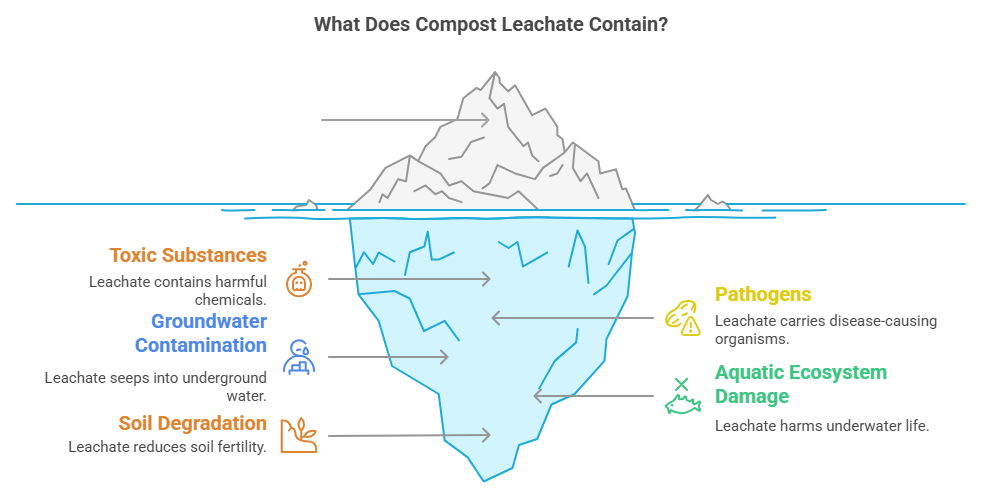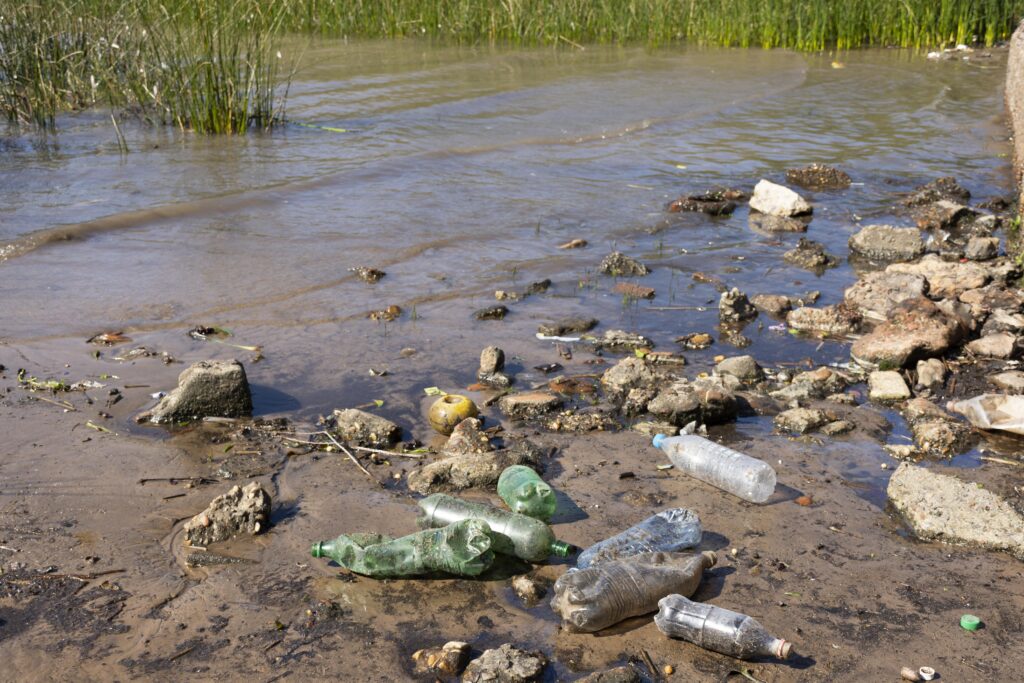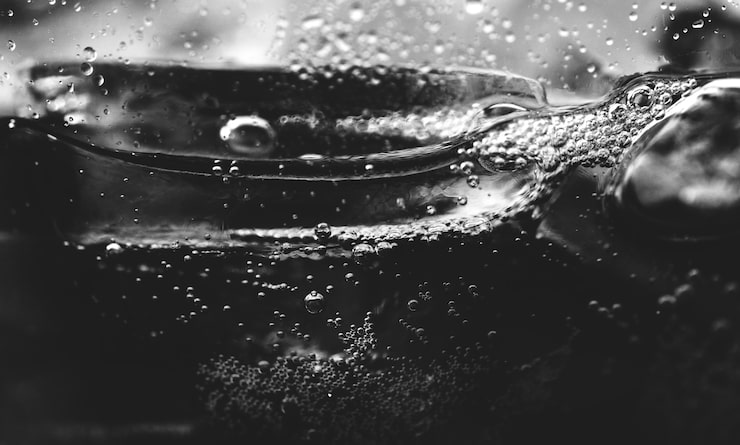Leachate can be a hidden threat to your water supply if you live near a landfill. It is a toxic liquid that forms in landfills and can pollute nearby water sources. This blog will look into how it is a major threat and how landfill monitoring can manage the challenge.
What Is Leachate and How Does It Form?
Leachate is a liquid that is formed when water percolates through waste, leading to it picking up toxic substances. Natural processes such as rainfall, melting of snow, and moisture accumulation from waste running off towards water bodies.
So, how is leachate formed? Different waste types, such as organic waste, heavy metals, and chemicals, can come together to make leachates highly polluting. Here’s a chart explaining the common components that are found in landfill leachate:
| Component | Source | Environmental Risk |
|---|---|---|
| Heavy Metals (e.g., Pb, Cd) | Batteries, electronics | Toxic to aquatic life |
| Ammonia & Nitrates | Organic waste, fertilisers | Algal blooms, oxygen depletion |
| VOCs (Volatile Organic Compounds) | Paints, solvents | Groundwater carcinogens |
| Pathogens | Food & medical waste | Health hazards in water systems |
Table 1: Common Components Found in Landfill Leachate
How Leachate Can Seriously Harm Water Quality
Compost Leachate is highly toxic, as it is created from the interaction of water with solid waste materials within a landfill. As rainwater or decomposing waste runoffs percolate through the buried rubbish, it can undergo complex physical, biological, and chemical transformations. This happens because this liquid is reactive, and it picks up toxic substances and pathogens, leading to the creation of an extremely polluted effluent.
This leachate, once it enters groundwater or surface water, can pollute drinking water supplies, harm aquatic ecosystems, and lead to long-term soil degradation. However, the primary reasons why it is dangerous to water quality include:
- It pollutes drinking water supplies
- It harms aquatic ecosystems
- It leads to long-term soil degradation
Essentially, it can lead to groundwater contamination, leading to the water becoming unsafe to use. This is, however, a more critical challenge in older and unlined landfills. Now, since groundwater is a major source of drinking and agricultural water in Australia, leachate can lead to the contamination of the most necessary source of water.
Furthermore, it can also lead to the pollution of nearby natural water bodies, leading to disruptions in the local aquatic ecosystem and the death of fish and other underwater organisms. Also, leachate can alter the chemical composition of soil, thus reducing its fertility and disrupting the natural biological processes.

A Scathing Evaluation of Leachate Contamination in Australia
Australia has faced challenges related to leachate contamination due to a vast network of new and existing landfills and a constantly shifting climate. Speaking of the impact of climate change, more rainfall has led to more water runoff, leading to increased leachate production.
Additionally, Australia has its share of older and closed landfills, which lack effective liners and other environmental protection standards introduced later. These sites, at the risk of flooding and erosion, can release contaminants into the surrounding environment.
It is due to these risks that the environmental watchdog groups, such as the Environmental Protection Authority (EPA) Victoria, Friends of the Earth Melbourne (FoEM), and so on, have raised concerns regarding the existing compliance standards for landfills.
They have focused on implementing stricter standards to undertake proactive monitoring and management for preventing the chances of environmental harm.
In this context, the high-risk landfill zones in Australia are:
| Region | Areas of Concern | Is Monitoring Needed? |
|---|---|---|
| Melbourne suburbs | Urban landfills near residential areas | Yes |
| Regional Victoria | Older, unlined rural landfills | Yes |
| Coastal QLD | High rainfall, proximity to wetlands | Yes |
Table 2: High-Risk Landfill Zones in Australia
The Detection and Monitoring of Leachate
The modern environmental management systems can rely on different sophisticated monitoring approaches that detect and prevent leachate contamination before it can cause significant levels of damage.
These monitoring systems often include:
- Groundwater Monitoring Wells: Around landfills, a network of wells is installed that extracts groundwater samples to test for contaminants. In this case, regular testing can reveal changes in the water quality and can detect early signs of leakages and contamination.
- Leachate Collection Pipes: The modern landfills are built with engineered collection systems where leachates are directed into tanks for storage as well a for treatment. Evaluating the composition of the collected sample can be crucial.
- Real-time Sensors: Modern monitoring systems can include automated sensors that measure parameters such as pH, conductivity, and temperature. Any chemical anomaly these sensors can present early warning signs, facilitating timely intervention.
Management and Treatment of Leachates
Modern landfills often implement a multi-layered approach that involves specifically designed barriers and advanced treatment techniques. The list of leachate management and treatment techniques can be noted as:
Containment of Leachates
The first task of the multilayered approach is to prevent leachate from seeping into the soil. This can be performed with the help of specifically engineered barriers installed in landfills. These barriers are often made of geomembranes installed at landfill bases that prevent leachates from seeping into the soil.
Alternatively, drainage layers can also be used where special gravel or geotextiles channel the leachate into a network of pipes for collection.
Options for Treatment
Leachate treatment is not just possible. In fact, in many cases, leachate treatments are even recommended. Some of these treatment options include:
- Biological Treatments: In this context, microbes are used to break down organic contaminants in the leachate, making it a cost and eco-friendly option for treating leachate from seeping into the soil.
- Evaporation Ponds: In some of the locations, evaporation ponds collect leachates and evaporate naturally. This is, however, less common in urban areas as it requires a major space investment.
- Membrane Filtration: Some processes, such as reverse osmosis and ultrafiltration to remove salts and other inorganic pollutants from the liquid.
Here is a chart exploring the three treatment options:
| Methods | Pros | Cons | Suitability |
|---|---|---|---|
| Biological Treatment | Cost-effective, eco-friendly | Slower, less effective for chemicals | Organic-heavy leachate |
| Evaporation Ponds | Low energy use | Requires space + hot climate | Regional landfills |
| Membrane Filtration | High removal efficiency | Expensive setup | Industrial landfills |
Table 3: Leachate Treatment Methods Overview
Inference: Why Leachate Must Be Taken Seriously
Leachate needs to be essentially considered a serious environmental risk that can be a significant threat to Australia’s water quality and ecosystems. Due to expanding urban areas, climate unpredictability, and legacy issues from older and unlined landfills, it is now more important than ever to have proactive environmental management.
Having understood how leachates can be harmful, the important inference drawn is that modern landfill monitoring and management are extremely important. Thus, effective containment, early detection, and effective treatment need to be considered essential to safeguard Australia’s water resources for the future.
Final Thoughts
To reiterate, leachate is an invisible but serious environmental risk. Without proper containment and monitoring, it can contaminate drinking water and damage ecosystems for decades. Thus, with proper landfill monitoring systems and other protective measures, containing and managing leachates is crucial for environmental sustainability.
How Our Landfill Monitoring Services Help
Worried about leachate pollution in your landfill or nearby site? At SERS, our team provides expert landfill monitoring and groundwater protection services. So, what are you waiting for? Book a consultation today!
Frequently Asked Questions
What Factors Mainly Affect Leachates?
The factors that influence leachates are landfill age, the composition of waste within the landfill, as well as natural factors such as precipitation and moisture. Other aspects such as the temperature and landfill covering systems, can also affect leachates.
What is a Leachate Loophole?
Many leachate control measures involve sewage plants that are not well-equipped to treat the leachate. This creates a regulatory loophole, and this is why critical leachate removal measures are required.
How Can Leachate Be Transferred From Landfills to Wastewater Treatment Plants?
Some landfills have pipes that can connect directly to sewer systems. In other cases, landfills can use tanker trucks to manually transport leachate.
Does Leachate Threaten Public Health?
Leachate can significantly harm groundwater conditions. And in Australia, groundwater is the main source of drinking water. Thus, drinking contaminated water can definitely have a negative impact on the public health.





